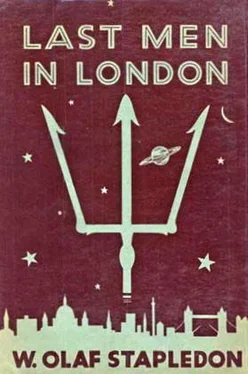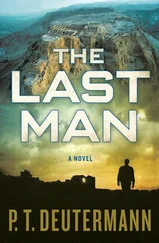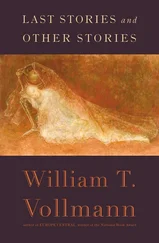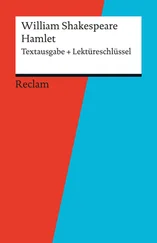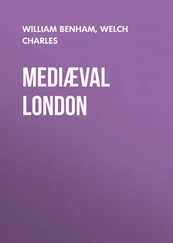At this point I will report a verbal fragment of communication which is typical of most that I have received, and seems to bear out many of the foregoing inferences.
‘Vain to live. Yet Life insists. Work insists. Too many thousands of men, of women, of crawling children with eyes festering. Too little food. Blue sun piercing the deep cloud-zone, parching the fields. Child meat in the flesh pots. Eat the mad, who come to grief. The many mad. Mad men with knives. Mad women with smiles, with skull-faces. (And I remember beauty.) Too many labours and fears. Too hot. Hateful proximity of men hot. Love one another? With sweat between! Love best in the water, the cooling water, that makes the body lighter. The pools, the rains, the house-uprooting storms, the everlasting cloud, blinding purple. God will come soon, they say it. To burn the world, to take away his friends. The God-dream. Too good, too cheap. Radiation the one God, all pervading, cruel. To die quickly, to sleep and not wake! But life insists, work insists. Vain work insists. Yet why? The old far days, Godless, beautiful. The glorious world. The fair world of men and women and of the single awareness. Eye of the cosmos. Heart of the cosmos. Cunning hand. Then, we faced all things gaily. Even this corruption, when we foresaw it, we called “a fair end to the brief music that is man”. This! The strings all awry, screaming out of tune, a fair end!’
This passage is typical, though more coherent than most. There are others more striking, but so repugnant to the taste of my contemporaries that I dare not repeat them, passages describing the prevailing brutishness of sexual relations in a population that had already so far degenerated that neither sex could interest the other save in the crudest manner. This impoverishment of sexual life was due to the fact that physical health and beauty had been undermined, that apprehension of the more delicate, aesthetic and spiritual aspects of experience had become almost impossible, that the realization of other individuals as living personalities was very uncommon. Nearly all behaviour was the impulsive behaviour of beasts, though of beasts in whose nature were incorporated many tricks derived from a forgotten humanity.
Some men and women there still were who had not permanently sunk to this brutish level. Several communications make it clear that, although the culture and the actual mental capacity of the Last Men were by now so degenerate, some few, a scattered and dwindling aristocracy, were still capable, at least intermittently, of personal love, and even of perplexed loyalty to certain ideals of conduct. The evidence for this lies in such passages as the following, which with its fleeting recovery of the earlier intelligence, and its bewildered groping after a forgotten ecstasy, affords perhaps the right conclusion to this book.
‘She lies motionless in the shallow water. The waves, fingering, the hot sand, recoil steaming. Her flesh, translucent formerly, now is filmed and grey, blind like her filmed eyes. We have taken of each other very deeply. The heat tricks us sometimes into intolerance each of the other’s unyouthful body, unpliant mind; yet each is the other’s needed air for breathing. We have ranged in our work very far apart, she into the astronomical spaces, I into the pre-historical times. But now we will remain together until the end. There is nothing more for us to do but to remember, to tolerate, to find strength together, to keep the spirit clear so long as may be. The many aeons of man! The many million, million selves; ephemeridae, each to itself, the universe’s one quick point, the crux of all cosmical endeavour. And all defeated! The single, the very seldom achieved, spirit! We two, now so confused, participated once in man’s clearest elucidation. It is forgotten. It leaves only a darkness, deepened by blind recollection of past light. Soon, a greater darkness! Man, a moth sucked into a furnace, vanishes; and then the furnace also, since it is but a spark islanded in the wide, the everlasting darkness. If there is a meaning, it is no human meaning. Yet one thing in all this welter stands apart, unassailable, fair, the blind recollection of past light.’
He was born in Seacombe, Wallasey, on the Wirral peninsula near Liverpool, the only son of William Clibbert Stapledon and Emmeline Miller. The first six years of his life were spent with his parents at Port Said. He was educated at Abbotsholme School and Balliol College, Oxford, where he acquired a BA in Modern History in 1909 and a Master’s degree in 1913. After a brief stint as a teacher at Manchester Grammar School, he worked in shipping offices in Liverpool and Port Said from 1910 to 1913. During World War I he served with the Friends’ Ambulance Unit in France and Belgium from July 1915 to January 1919. On 16 July 1919 he married Agnes Zena Miller (1894-1984), an Australian cousin whom he had first met in 1903, and who maintained a correspondence with him throughout the war from her home in Sydney. They had a daughter, Mary Sydney Stapledon (1920-), and a son, John David Stapledon (1923-). In 1920 they moved to West Kirby, and in 1925 Stapledon was awarded a PhD in philosophy from the University of Liverpool. He wrote A Modern Theory of Ethics , which was published in 1929. However he soon turned to fiction to present his ideas to a wider public. Last and First Men was very successful and prompted him to become a full-time writer. He wrote a sequel, and followed it up with many more books on subjects associated with what is now called Transhumanism. In 1940 the family built and moved into Simon’s Field, in Caldy. After 1945 Stapledon travelled widely on lecture tours, visiting the Netherlands, Sweden and France, and in 1948 he spoke at the Congress of Intellectuals for Peace in Wrocław, Poland. He attended the Conference for World Peace held in New York in 1949, the only Briton to be granted a visa to do so. In 1950 he became involved with the anti-apartheid movement; after a week of lectures in Paris, he cancelled a projected trip to Yugoslavia and returned to his home in Caldy, where he died very suddenly of a heart attack. Olaf Stapledon was cremated at Landican Crematorium; his widow Agnes and their children Mary and John scattered his ashes on the sandy cliffs overlooking the Dee Estuary, a favourite spot of Olaf’s, and a location that features in more than one of his books.
Source: Wikipedia
Also available on Feedbooks Stapledon:
• Star Maker (1937)
• Last and First Men (1930)
• Sirius: A Fantasy of Love and Discord (1944)
• Odd John: A Story Between Jest and Earnest (1935)
• A Modern Magician (1979)
• Death into Life (1946)
• Darkness and the Light (1942)
• A Man Divided (1950)
• A World of Sound (1936)
• The Seed and the Flower (1916)
Copyright:This work is available for countries where copyright is Life+50.
Note:This book is brought to you by Feedbooks
http://www.feedbooks.com
Strictly for personal use, do not use this file for commercial purposes.

Published:1932
Categorie(s):Fiction, Science Fiction
Source: http://gutenberg.org

www.feedbooks.com
Food for the mind
